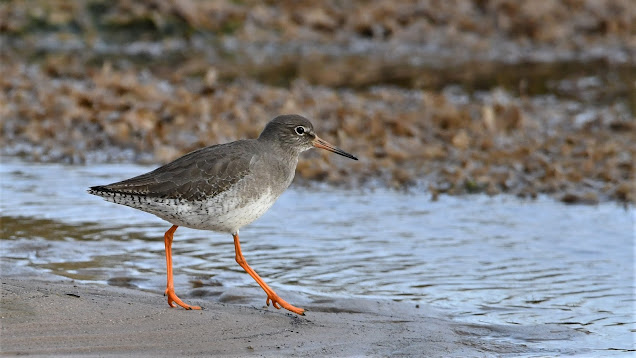February 10th. A hard frost and a bitter start to the morning, with a hint of a sleet shower but otherwise dry and fairly calm.
Offshore, reasonable numbers of Red-throated Divers were seen with a single Black-throated Diver heading south. Despite being a very common breeding bird, Meadow Pipits are usually in very low numbers here over Winter, being almost replaced by Rock Pipits in the marshes. However, a group of around 15 Meadow Pipits have been regularly around the Freshwater Marsh and Mere Meadow. A Water Rail was seen well from the Office at Sykes Farm. An evening roost watch was rewarded with 52 Whooper Swans and 75 'alba' Wagtails around Tennyson's Sands.
February 9th. Slightly less cold this morning, remaining dry and bright and warming up considerably during the day.
An atmospheric start this morning with the calls of over 1200 Lapwing and 1500 Golden Plover around Tennyson's Sands, with 2000 Pink-footed Geese arriving later. Also in the area 3 Cetti's Warbler, 2 Water Pipit, and a Barn Owl. Around the West Dunes were 24 Redwing and 3 Siskin.
February 8th. Weather pattern much as per the previous two days.
22 Whooper Swans were around early morning with around 2800 Lapwing were moving between Croftmarsh and the River haven with 2000 Golden Plover, 800 Oystercatcher, and 800 Pink-footed Geese coming off local fields. Other birds around included 754 Eider, 650 Wigeon, 2 Grey Partridge, a Goldeneye, a Goldcrest, 3 Woodcock, 9 Snow Bunting and 2 Redwing. 2 southbound Rook passed over Croftmarsh - a typical February occurrence that we usually take as an indicator of early spring movement.
February 7th. Another cold, frosty start, but continuing bright, sunny and calm.
The Whooper Swans left the roost shortly after dawn but some were heard to return at dusk later. On the Haven, waterbirds included 3500 Golden Plover, 3500 Knot, 1950 Lapwing and 800 Wigeon. Other birds around included 2 Cetti's Warbler, 16 Corn Bunting, 4 Marsh Harrier, a Merlin and a Short-eared Owl.
February 6th. The day started with a hard frost, continued, bright, sunny and calm and ended with a beautiful sunset.
Records again from the west side today where an Avocet was new in on Tennyson's Sands, where 103 Shoveler was a good count and 2 Water Rails showed. Good coverage of birds going to roost at dusk included; 3 Marsh Harrier, 2 ringtail Hen Harrier, 48 Whooper Swan and 52 Alba Wagtails.
February 5th. Weather much as yesterday but slightly colder.
Reports from the west side this morning. 900 Pink-footed Geese came out of the Wash roost and settled to graze on Croftmarsh and around 700 Brent Geese were around, variously coming in to wash on Tennyson's Sands and on the grazing marsh beyond. A Marsh Harrier was hunting the marsh and reedbeds here and several Skylarks were in song. 2 Bewick's Swans flew north-west.
February 4th. Mild, dry, overcast with only a light wind.
Good conditions for scanning the haven this morning and checking on Eider numbers - a total of 1140 were offshore and lining sand bars etc. 25 Great Crested Grebe here was suggestive of an influx, but there was no decent coverage of the sea today. One of the main themes was the movement of Pink-footed Geese, with 1500 leaving the wash roost at dawn and heading off north-west and then several skeins totaling 2660 came across from Norfolk and also headed of north-west. A strong southerly passage of Black-headed Gulls was also noted. Other birds around included 2 Water Pipits, 2 Stonechat and a drumming Great Spotted Woodpecker.
February 3rd. Remaining mild, dry and overcast with a light westerly breeze and a calm sea.
A significant increase in Red-throated Divers this morning, with a minimum of 400. A Black-throated Diver and 10 Little Gulls flew south. 15 Snow Buntings were again along the beach, with a male Hen Harrier and 2 Marsh Harriers hunting the saltmarsh. Two skeins of Pink-footed Geese, totaling 280,came over the Wash from Norfolk and headed north-west, a Barnacle Goose accompanying one group, while up to 600 Brents were grazing the meadow on Jackson's Marsh. Large numbers of waders gathered on the mudflats at low tide including 3000 Lapwing and 3000 Golden Plover. The Bearded Tit was back on Tennyson's Sands and 2 Water Pipits flew over Sykes Farm. Two Grey Partridges were seen down Mill Pond Road early morning, with one heard calling from Mill Hill later.
February 2nd. Mild, sunny and dry with a westerly breeze.
193 Red-throated Diver flew into the Wash on the ebb tide, but otherwise, no change at sea and 15 Snow Buntings remained on the beach. A male Hen Harrier was hunting the Outer Dunes. A Mistle Thrush was new in on Jackson's Marsh.
February 1st. Another bright, sunny, winters day, after a light frost overnight. Westerly wind increasing
A morning seawatch involved 106 Red-throated Diver, 254 Eider and 29 Great Crested Grebes heading south along with quite a pronounced southerly passage of Gulls. Two Marsh Harriers moving south about 200 metres offshore and spaced about 150 metres apart was unusual and followed 10 minutes later by a male Hen Harrier cruising south along the beach. Later, 4 Marsh Harriers came in to roost. Other birds around included 17 Snow Bunting and single Water Pipit, Goldcrest, Woodcock and Siskin.








